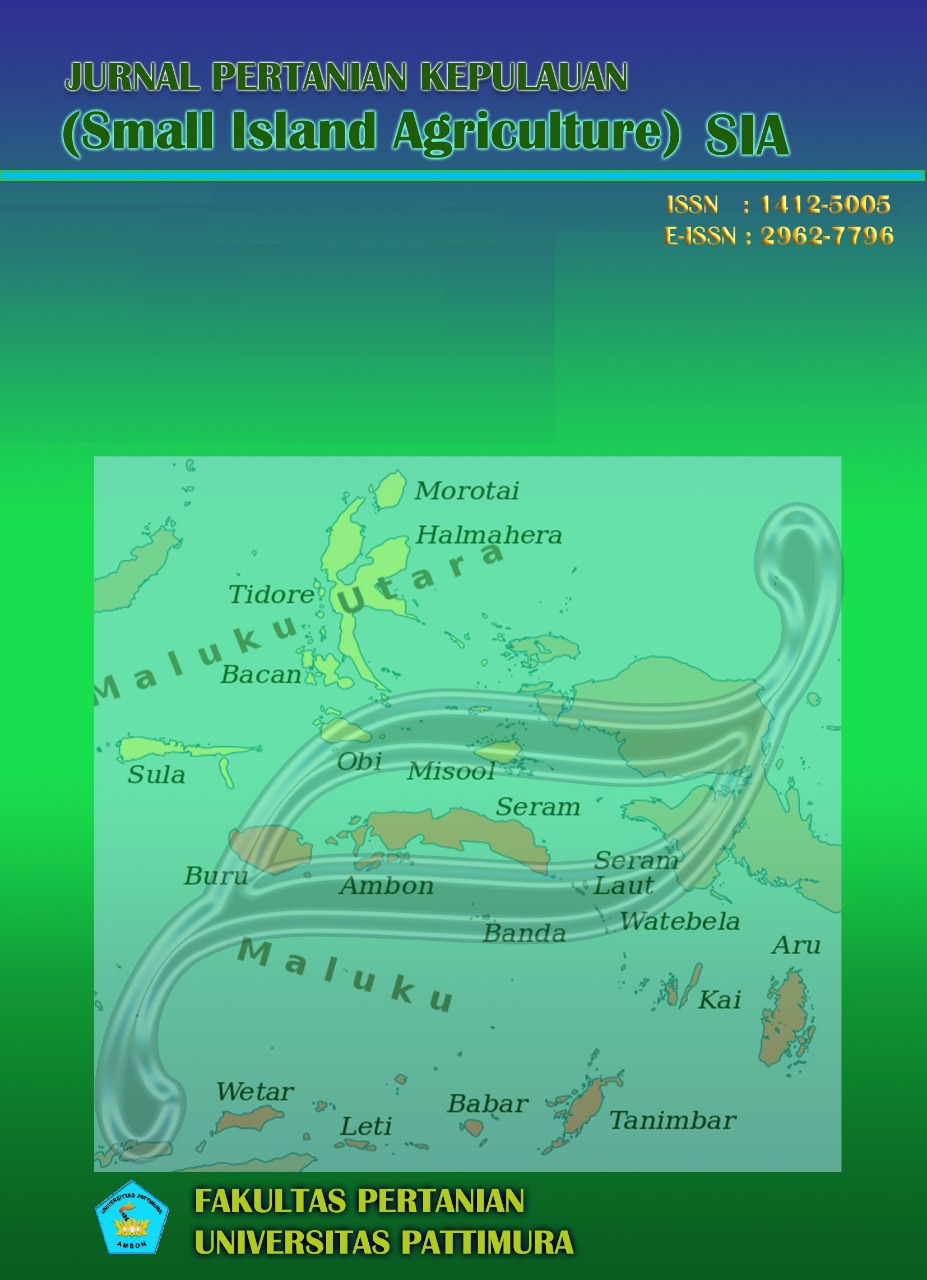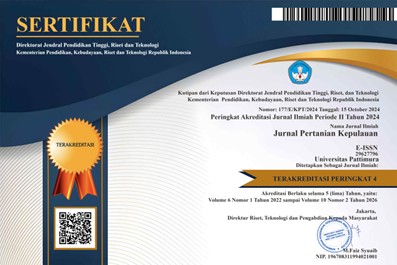Potensi Minyak Atsiri Kayu Manis dan Kayu Lawang Sebagai Pengendali Hayati Fusarium oxysporum
Abstract
This research aims to analyze the potential of essential compounds of Cinnamonum burmannii and Cinnamonum cullilawan as a bioagent for Fusarium oxysporum and to test the efficacy of both essential oils in controlling the growth of the fungus F. oxysporum. Oil extraction was carried out using the steam-water distillation method, and analysis of the components of the oil compounds of the cinnamon was carried out using the GC-MS method. Essential oils were tested for their efficacy for inhibiting F. oxysporum with four concentrations, namely 0.06%, 0.125%, 0.25%, and 0.5% on PDA and PDB media. The results show that the main essential compound in C. burmannii is cinnamaldehyde at 20.61%, and in C. cullilawan, it is eugenol at 26.33%. The essential compounds of both have antifungal activity against F. oxysporum, with a concentration rate of 0.125% being able to inhibit the growth of F. oxysporum. The main active compounds, such as cinnamaldehyde and eugenol, play an important role in the fungus control mechanism. This research concludes that the essential compounds from both have the potential to inhibit F. oxysporum growth.
Downloads
References
AAbd-Alla, M. A. , N. G. E. , & E. R. H. (2013). Effect of some natural plant extracts & plant essential oils on suppressive of Penecillium digitatium (Pers.:Fr.) Sacc. and its enzyme activity which caused citrus green mold for navel oranges in Egypt. Jurnal of Applied Sciences Research, 9(6), 4073–4080.
Abdila, A. N., & Maduratna, M. (2021). Uji efektivitas fungisida nabati (kombinasi tepung jagung dan ekstrak daun sirsak) dalam mengendalikan penyakit layu fusarium (fusarium oxysporum) pada tanaman cabai. Jurnal Nasional Holistic Science, 1(1), 17–20. https://doi.org/10.30596/jcositte.v1i1.xxxx
Achmad, A., & Mulyaningsih, I. (2016). Pengaruh pH, Penggoyangan Media, dan Ekstrak Daun Sirih Merah (Piper crocatum Linn.) terhadap Pertumbuhan Cendawan Rhizoctonia sp. Jurnal Hortikultura, 25(2). https://doi.org/10.21082/jhort.v25n2.2015.p150-159
Achmad Achmad, I. M. (2015). Pengaruh pH, Penggoyangan Media, dan Ekstrak Daun Sirih Merah (Piper crocatum Linn.) terhadap Pertumbuhan Cendawan Rhizoctonia sp. Jurnal Hortikultura, 25(2), 150–159.
Amalia, D., Ngadiwiyana, & Fachriah, E. (2013). Sintesis Etil Sinamat pada Minyak Kayu Manis dan Uji Aktivitas Sebagai Antidiabetes. Jurnal Sains Dan Matematika, 21(4), 108–113.
Astri Afriani, M. H. F. S. H. (2019). Efektivitas gliocladium virens untuk mengendalikan penyakit Fusarium oxysporum sp. capsici pada tanaman cabai. Pertanian Tropik, 69(3), 403–411.
Dessy Herwanti, I. S. B. S. S. (2019). Pengaruh Dosis Gliokompos dalam Mengendalikan Penyakit Layu Fusarium Pada Tanaman Cabai Hiyung (Capsicum frutescens L.). Proteksi TanamanTropika, 2(3), 151–156.
Direktorat Jendral Perkebunan. (2021). Produksi hasil tanaman non hutan di indonesia.
Elbestawy, M. K. M., El-Sherbiny, G. M., & Moghannem, S. A. (2023). Antibacterial, Antibiofilm and Anti-Inflammatory Activities of Eugenol Clove Essential Oil against Resistant Helicobacter pylori. Molecules, 28(6). https://doi.org/10.3390/molecules28062448
Giordani, R. , H. Y. , & K. J. (2008). Compositions and antifungal activities of essential oils of some Algerian aromatic plants. Fitoterapia, 79(3), 199–203.
Gulab N. Jham, O. D. D. C. M. J. & V. M. V. (2005). Identification of the Major Fungitoxic Component of Cinnamon Bark Oil. Fitopatologia Brasileira, 30, 404–408.
Hariharan, G., & Prasannath, K. (2021). Recent Advances in Molecular Diagnostics of Fungal Plant Pathogens: A Mini Review. In Frontiers in Cellular and Infection Microbiology (Vol. 10). https://doi.org/10.3389/fcimb.2020.600234
Heriyanto, H. (2019). Kajian Pengendalian Penyakit Layu Fusarium oxysporum dengan Trichoderma sp. pada Tanaman Cabai. Jurnal Ilmu-Ilmu Pertanian, 21(2), 26.
Hu, L., Wang, D., Liu, L., Chen, J., Xue, Y., & Shi, Z. (2013). Ca2+ Efflux Is Involved in Cinnamaldehyde-Induced Growth Inhibition of Phytophthora capsici. PLoS ONE, 8(10). https://doi.org/10.1371/journal.pone.0076264
I Made Tedi Mahadi Putra, T. A. P. N. W. S. (2019). Pengendalian Penyakit Layu Fusarium oxysporum f.sp. capsici pada Tanaman Cabai Rawit Capsicum frutescens di Rumah Kaca dengan Trichoderma sp yang Ditambahkan pada Kompos. Agroekoteknologi Tropika , 8(1), 103–117.
Ilmi, I. N., Filianty, F., & Yarlina, V. P. (2022). Sediaan Kayu Manis (Cinnamomum Sp.) sebagai Minuman Fungsional Antidiabetes. Jurnal Kimia Padjadjaran, 1, 31–59. https://jurnal.unpad.ac.id/jukimpad
Isman, M. B. (2000). Plant essential oils for pest and disease management. Crop Protection, 19(8–10), 603–608. https://doi.org/10.1016/S0261-2194(00)00079-X
Julianus Sohilait, H. (2016). GC/GC-MS Analysis, Isolation and Identification of Bark Essential Oil Components from <i>Cinnamomum culilawan</i>, Blume. American Journal of Applied Chemistry, 4(4), 157. https://doi.org/10.11648/j.ajac.20160404.16
Kishore, G. K., Pande, S., & Harish, S. (2007). Evaluation of essential oils and their components for broad-spectrum antifungal activity and control of late leaf spot and crown rot diseases in peanut. Plant Disease, 91(4), 375–379. https://doi.org/10.1094/PDIS-91-4-0375
Kocevski, D., Du, M., Kan, J., Jing, C., Lačanin, I., & Pavlović, H. (2013). Antifungal effect of allium tuberosum, cinnamomum cassia, and pogostemon cablin essential oils and their components against population of aspergillus species. Journal of Food Science, 78(5). https://doi.org/10.1111/1750-3841.12118
Liza YE, A. A. T. J. (2015). Variability of Fungal Rhizosphere and Its Role as Antagonist Agents of Fusarium oxysporum Causing Wilt Disease in Crysanthenum sp. Jurnal Fitopatologi Indonesia.
Meriza Fatma, M. C. M. F. D. H. (2021). Pengaruh Ekstrak Daun Pepaya (Carica papaya L.) terhadap Diameter Koloni dan Persentase Penghambatan Pertumbuhan Fusarium oxysporum. Serambi Biologi, 6(2), 9–14.
Mulyanti, N. , H. R. , M. S. , & S. D. (2023). Analisis Minyak Atsiri Pada Kulit Kayu Manis (Cinnamomum Burmanii) Dengan Metode Gass Chromatography-Mass Spectrometry (Gc-Ms). Jurnal Farmasi Malahayati, 6(2), 203–210.
Novita. (2008). Peran daun cengkeh terhadap pengendalian layu fusarium pada tanaman tomat. Jurnal Agronomi, 12(2), 14–17.
Olea, A. F., Bravo, A., Martínez, R., Thomas, M., Sedan, C., Espinoza, L., Zambrano, E., Carvajal, D., Silva-Moreno, E., & Carrasco, H. (2019). Antifungal activity of eugenol derivatives against Botrytis cinerea. Molecules, 24(7). https://doi.org/10.3390/molecules24071239
OuYang, Q., Duan, X., Li, L., & Tao, N. (2019). Cinnamaldehyde exerts its antifungal activity by disrupting the cell wall integrity of Geotrichum citri-aurantii. Frontiers in Microbiology, 10(JAN). https://doi.org/10.3389/fmicb.2019.00055
Pise, V. H., Harlalka, R., & Thorat, B. N. (2023). Chemical Composition of Essential Oils. In Drying of Aromatic Plant Material for Natural Perfumes. https://doi.org/10.1201/9781003315384-7
Rizki, S. M., & Panjaitan, R. S. (2018). Efektivitas Antifungi dari Minyak Atsiri Kulit Batang Kayu Manis (Cinnamommum burmanni) terhadap Candida albicans. EduChemia (Jurnal Kimia Dan Pendidikan), 3(2), 172. https://doi.org/10.30870/educhemia.v3i2.4560
Saroj, A., Srivastava, A. K., Nayak, A. K., Chanotiya, C. S., & ... (2018). Essential Oils in Pest Control and Disease Management. …. https://doi.org/10.1201/9780429426155-17
Sastrohamidjojo, H. (2005). “Prospek Minyak Atsiri Indonesia”. , 26-27 Mei 2005. Proyek ITTO. (Personal Comm.). Seminar Nasional Peningkatan Produktivitas Hutan.
Siddiqui, T., Khan, M. U., Sharma, V., & Gupta, K. (2024). Terpenoids in essential oils: Chemistry, classification, and potential impact on human health and industry. Phytomedicine Plus, 4(2), 100549. https://doi.org/https://doi.org/10.1016/j.phyplu.2024.100549
Sohilait, H. J. (2015). Chemical composition of the essential oils in Eugenia caryophylata, Thunb from Amboina Island. Science Journal of Chemistry. https://www.researchgate.net/profile/Hanoch-Sohilait/publication/295547004_Chemical_Composition_of_the_Essential_Oils_in_Eugenia_caryophylata_Thunb_from_Amboina_Island/links/56cb1e0b08ae5488f0dae07f/Chemical-Composition-of-the-Essential-Oils-in-Eugenia-caryophylata-Thunb-from-Amboina-Island.pdf
Syarifudin, R., Kalay, A. M., & Uruilal, C. (2021). Effect of Biological Fertilizer and Chemical Fungicide on Fusarium Wilt Disease, Growth and Yield on Onion (Allium ascaloncum L). Agrologia, 10(2). https://doi.org/10.30598/ajibt.v10i2.1426
V. R. Wati, Y. dan E. F. (2020). Pengaruh solarisasi tanah dan pemberian dosis Trichoderma harzianum dalam pengendalian penyakit layu Fusarium pada cabai (Capsicum annum L.). Agro Complex, 4(1), 40–49.
Wang, M., Liu, H., Dang, Y., Li, D., Qiao, Z., Wang, G., Liu, G., Xu, J., & Li, E. (2023). Antifungal Mechanism of Cinnamon Essential Oil against Chinese Yam-Derived Aspergillus niger. Journal of Food Processing and Preservation, 2023, 1–9. https://doi.org/10.1155/2023/5777460
Wang, Y., Feng, K., Yang, H., Zhang, Z., Yuan, Y., & Yue, T. (2018). Effect of cinnamaldehyde and citral combination on transcriptional profile, growth, oxidative damage and patulin biosynthesis of Penicillium expansum. Frontiers in Microbiology, 9(MAR). https://doi.org/10.3389/fmicb.2018.00597
Wei, J., Bi, Y., Xue, H., Wang, Y., Zong, Y., & Prusky, D. (2020). Antifungal activity of cinnamaldehyde against Fusarium sambucinum involves inhibition of ergosterol biosynthesis. Journal of Applied Microbiology, 129(2). https://doi.org/10.1111/jam.14601
Zhou, X. (2023). The potential role of plant secondary metabolites on antifungal and immunomodulatory effect. Applied Microbiology and Biotechnology, 107(14), 4471–4492. https://doi.org/10.1007/s00253-023-12601-5
Copyright (c) 2025 Siti Harir hariroh, Ilyaz Marzuki, Christoffol Leiwakabessy, Abraham Talahaturuson

This work is licensed under a Creative Commons Attribution 4.0 International License.





.png)


